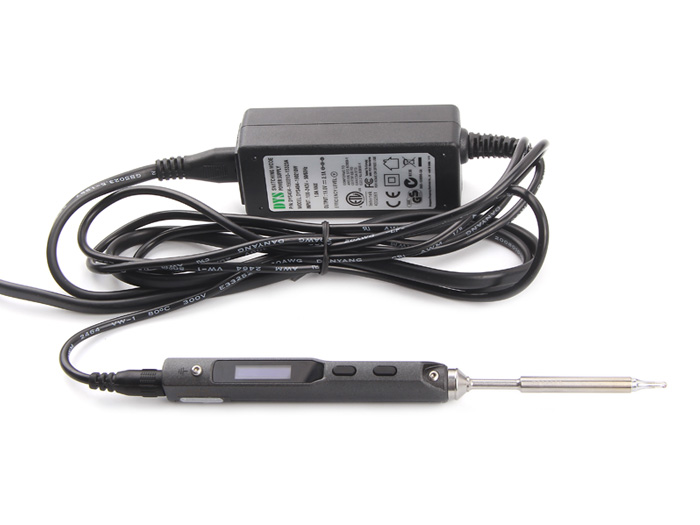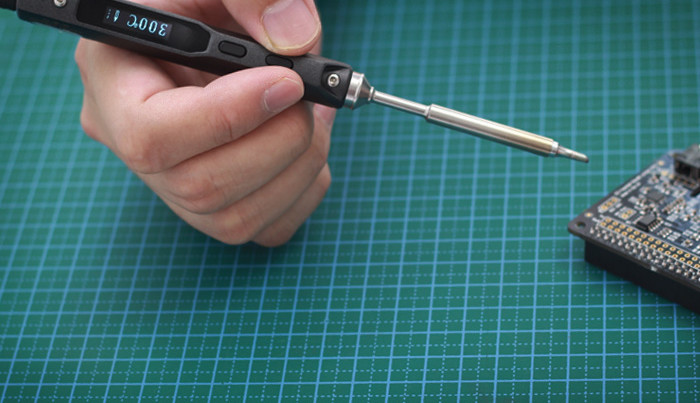By Harry Baggens (lol)
 Seeed Studio miniature soldering iron
Seeed Studio miniature soldering iron
The Chinese company Seeed Studio offers a lot of interesting things for electronics enthusiasts. Along with selling products from various manufacturers, Seeed develops and produces their own products, many of which are very innovative. For instance, a year ago we had a close look at the DSO Nano V3 miniature oscilloscope.
Seeed has also developed their own miniature soldering iron, which is now available in a European version. The unique thing about this soldering iron is that a display and the control circuitry are integrated into the grip. From the photos and Seeed’s description, it looked like a good idea for us to get our hands on one and try it out in the Elektor Labs.
Along with the soldering iron and the associated tip and AC power adapter, the box contains a power cable, a grounding wire with a clip’, an Allen wrench and some spare tips.
The miniature soldering iron is compact (16.8 x 1.65cm) and looks more like a fat fountain pen than a soldering iron. The grip is made from plastic with a sturdy feel. A small OLED display and two pushbuttons are located on the side of the grip (or is it the top?). The tip slides into the front of the grip and is secured by tightening a small screw with the included Allen wrench. At the rear of the grip there is a power connector and a micro-USB connector for connection to a PC. The soldering iron has a rated power of 40W with the included AC power adapter. You can optionally connect a higher-capacity power supply (max. 24V). That boosts the power to 65W.

After you switch on the power, some messages initially appear on the OLED display, and after you press one of the buttons the preset temperature of 300˚C is displayed. The display is small but easy to read, but unfortunately the information on the display cannot be flipped for left-handed users. The miniature iron heats up quickly – the temperature rose from 20˚C to 300˚C in about 15 seconds. You can use the two buttons to select a different temperature (up to a maximum of 400˚C), but unfortunately the selected value is not saved for the next time you use the iron. If the iron is not used for three minutes, the control circuitry reduces the temperature to 200˚C and the iron remains in sleep mode until it is moved again (apparently it has an integrated motion sensor).The soldering iron is small, light, comfortable and easy to use. The power cable could be a bit more flexible, but that is of course difficult to change when you use a standard AC power adapter. We also did not test the power cable for heat resistance, which is a standard feature with a normal soldering iron. The included soldering iron tip has a fairly fine point and is suitable for most typical soldering tasks with leaded components. It can also be used with relatively large SMD components, but for finer work a tip with a narrower point would be desirable.The iron can also be connected to a computer through a micro-USB cable. The computer recognizes the soldering iron as a USB drive containing a file with the name CONFIG.TXT. After opening this file in Notepad, we saw a number of lines of text with various settings for operating temperature, standby temperature, wait time for standby and some other parameters. These values can be changed and then the file can be saved, after which the iron will use the new values the next time. The software is open source, so you could also modify or extend it as desired.This miniature soldering iron is very handy as a complement to your regular soldering iron. It is small and easy to take with you. The soldering performance is very good, and on top of that you can program it according to your wishes. With a price of around 100 euros, the iron is not exactly low-cost, but when an Elektor designer says he would like to buy one for home use, you know it’s worth the money.

